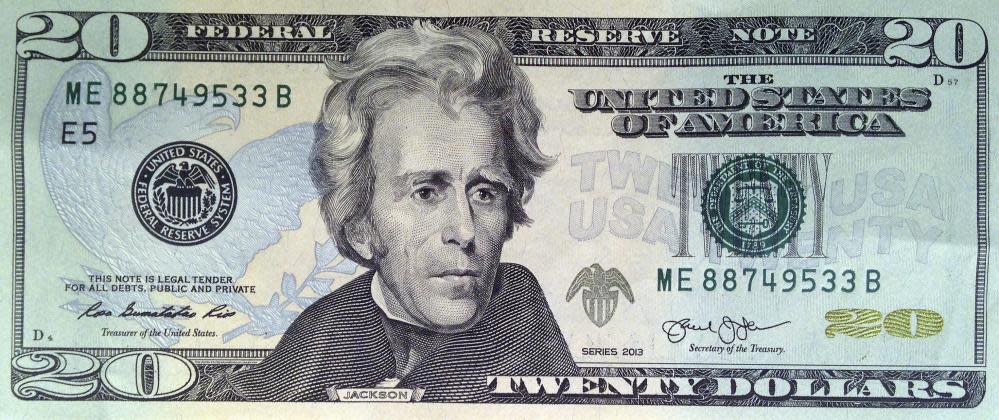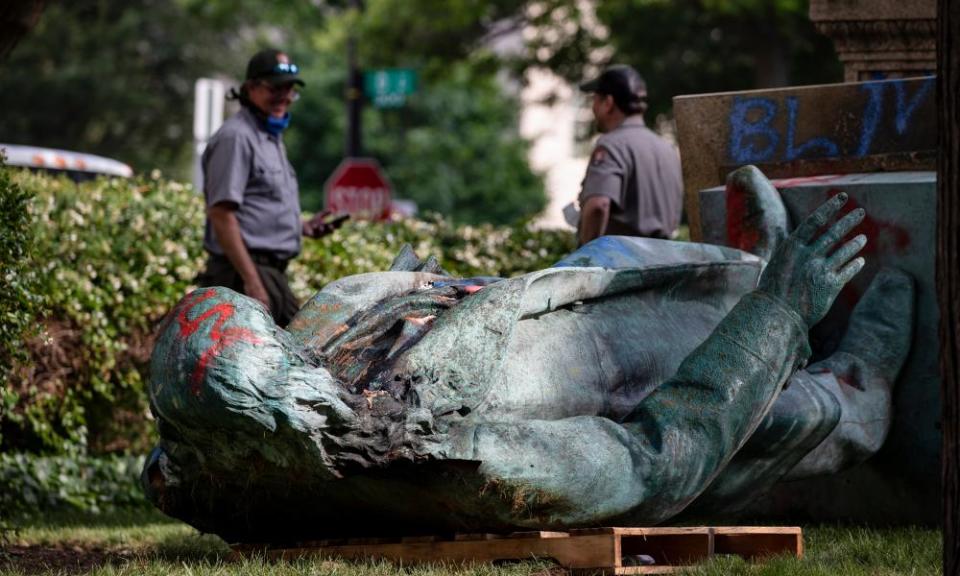'The worshipping of whiteness': why racist symbols persist in America

In life, the seventh US president, Andrew Jackson, and his family accrued their wealth at the expense of hundreds of enslaved people. Now, even in death, Jackson still wields the power to haunt Black Americans whenever they pull a $20 bill from their wallets.
“Racism isn’t always abrupt. It isn’t always in your face. Sometimes, it’s very insidious,” said Franklin Eugene Forbes II, an architect and urban planner. “Why am I, a Black person, using a bill where a man who believed I was inferior to somebody else as a way to buy things, the same way people that look like me were bought by him?”
For weeks now, historic protests against systemic racial inequity and injustice have also reinvigorated passionate debate around the most obvious memorials to slavery, white supremacy and racism across the United States. A growing number of the nearly 800 Confederate statues and monuments in the US have been removed, alongside a few toppled or defaced homages to founding fathers who profited from slavery.
Brands such as Aunt Jemima, Uncle Ben’s and Cream of Wheat are reconsidering the racial stereotypes emblazoned on their packaging. Gone With the Wind was temporarily pulled from HBO Max, and Nascar devotees no longer have the green light to unfurl Confederate battle flags at races.
But plenty of other symbols persist.
Abolitionist Harriet Tubman was supposed to supplant Jackson on the $20 bill. Then came the Trump administration.

The redesigned bill with Tubman’s portrait was originally expected to debut in 2020. But last year, the treasury secretary, Steve Mnuchin, announced that the unveiling had been delayed. He has since said the new version won’t be released for another decade and may not even feature Tubman.
“Maybe every single time you pay for something, you’re not thinking, ‘oh goodie, there’s Andrew Jackson, my hero.’ But in a way, that’s kind of the point, right?” said Alvita Akiboh, an assistant professor of history at the University of Michigan.
When Akiboh taught in Chicago, her students assumed that the local park in a majority Black and Latino neighborhood was named for Frederick Douglass, the famed abolitionist. It was instead a salute to Stephen A Douglas, an Illinois senator whose political machinations enabled slavery, and who is quoted saying: “I am in favor of confining citizenship to white men.”
Similar tributes to a checkered past exist all over the US, from streets named for Confederate officers and slave traders to congested highways originally designed to reinforce segregation and eliminate Black neighborhoods. When sports fans attend baseball or football games, they turn to the American flag and sing a national anthem penned by Francis Scott Key, a slave owner who abused his authority as district attorney to persecute Black men and abolitionists.
“I hope at least that the questioning that has started with monuments, because they’re visible, because they’re large, and because they’re easy to remove, will continue to happen as we start to re-evaluate the symbols on money, on our stamps,” Akiboh said. “The flags and other symbols that we use. The songs that we sing for our patriotic anthems. And that definitely, we will get to re-evaluate our K-12 curriculum.”

The attorney general, William Barr, recently came under fire when he casually quipped that “history is written by the winners”. For centuries, white Americans have always had the position and privilege to shape the country’s historical record.
“The American story has been a story of progress, of triumph, of victory, right? Of liberty and freedom,” said Daina Ramey Berry, Radkey professor of history at the University of Texas. But “enslaved people don’t fit well into that narrative”. nor do other racial minorities who have suffered because of the American experiment.
“That is the story of America, to have Trayvon Martin and Barack Obama simultaneously. To have Frederick Douglass, Abraham Lincoln and 4 million people enslaved simultaneously. That paradox is the American narrative,” said Rhae Lynn Barnes, an assistant professor in Princeton University’s history department.
Aspirational depictions of a city upon a hill and liberty and justice for all lose their luster when they’re juxtaposed against the systematic genocide of indigenous peoples, or an intricate slave-based economy rubber-stamped by revolutionaries fighting for their own freedom. But more dated history textbooks rarely provide that level of insight around how minority communities were treated during the country’s early years, and slavery gets all but erased – “there’s no discussion of what life was like in the United States prior to 1860, or if it is, it’s just African Americans were enslaved in this country, and the civil war freed them,” said Berry.
It’s this inconsistent retelling that has allowed for the veneration of deeply flawed characters, whose biographies are often cherry-picked for effect. Many of the founding fathers, including George Washington and Thomas Jefferson, were slaveholders, despite waxing poetic about how the institution was a “moral depravity”. Even Benjamin Franklin, revered as an early abolitionist, owned enslaved people for much of his life and ran ads selling others in his newspaper.
Champions of these men often attribute their moral failings to the sociopolitical environment in which they lived. But “just because slavery was accepted among white elites or even the broader white population at the time does not mean it was accepted by everybody, because everybody includes Black people who were enslaved, indigenous people who were pushed off their lands in order to expand plantation slavery,” said Akiboh.

A different logic has been used to justify the Confederate shrines that commemorate men who committed treason in an effort to uphold slavery. Defenders, including Donald Trump, decry “the history and culture of our great country being ripped apart”. But the monuments they are trying to protect aren’t usually civil war artifacts; they were instead erected decades after the conflict ended, as “a reminder for Black and brown people to remember their place”, said Akiboh.
Meanwhile, book publishers, songwriters, Madison Avenue advertisers and Hollywood studios immortalized the racist caricatures and racial stereotypes such as Aunt Jemima that have recently fallen under scrutiny, said Karen Cox, a professor of history at the University of North Carolina at Charlotte. Even Mickey Mouse, a beloved American staple, rose to prominence in 1928 with a tune from blackface minstrelsy, Barnes said.
“The racism and white supremacy is our national sin,” said Cox. “It doesn’t belong to the south.”
Much like currency, larger objects and icons have often been resistant to change, despite public repudiation of them; as recently as last year, more than 1,700 publicly sponsored symbols of the Confederacy still appeared everywhere from Maine to Washington state, according to a report by the Southern Poverty Law Center. Almost any relic’s retirement seems to get blowback from subgroups of Americans, for reasons ranging from historical preservation to outright bigotry.
“It’s all about shoving this down people’s throats and erasing the history of the white people, and I think that’s wrong,” Virginia state senator Amanda Chase recently exclaimed in a video.
When earlier this month Nascar hosted the first major sporting event with fans since the coronavirus pandemic, a plane with a gargantuan Confederate battle flag flew across the skyline to protest against the new ban. Far from an isolated incident, overt tributes to the Confederacy and acts of racial terror are still common in the US.
At least 34 Confederate monuments have been dedicated since 2000. In the last few years, high school students in states such as New Jersey, Illinois, Connecticut, Minnesota and California have been caught donning blackface, sometimes alongside a racial slur or Confederate flag.
But even the US’s bloated catalogue of racist iconography barely scratches the surface of a more general “built environment” and way of seeing that’s deeply embedded in the country’s infrastructure, suggested Sherwin K Bryant, an associate professor of African American studies and history at Northwestern University.
“Every single arena and area of American life is dominated by a kind of worshipping of whiteness,” he said. “And so this is inescapable.”

